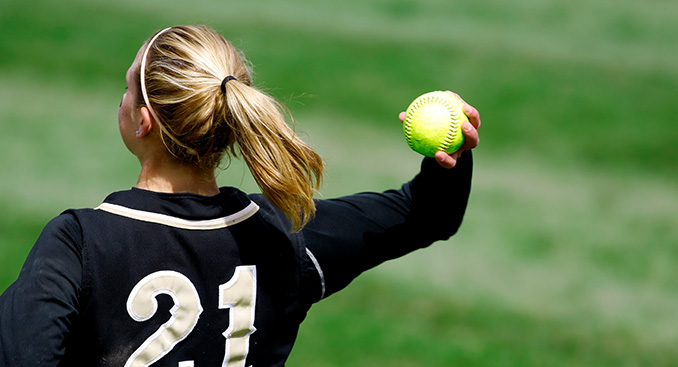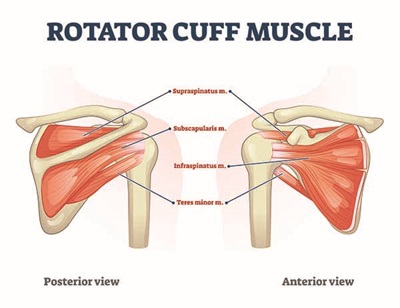What to Know About Rotator Cuff Injuries and Repair

The unique configuration of your shoulders make them the most flexible joints on your body, but also puts them at increased risk for instability and injury.
 “The shoulder is a weird joint in comparison to other parts of your body,” says David Taylor MD, an orthopedic surgeon with the TriHealth Orthopedic & Sports Institute. “It’s not a true ball and socket joint like the hip, where the ball is held in by the socket, but rather a large ball in a shallow socket. Think of a golf ball sitting on top of a large tee.” The shoulder’s stability relies on a balance of muscle forces rather than bony constraint.”
“The shoulder is a weird joint in comparison to other parts of your body,” says David Taylor MD, an orthopedic surgeon with the TriHealth Orthopedic & Sports Institute. “It’s not a true ball and socket joint like the hip, where the ball is held in by the socket, but rather a large ball in a shallow socket. Think of a golf ball sitting on top of a large tee.” The shoulder’s stability relies on a balance of muscle forces rather than bony constraint.”
The “ball” in your shoulder is the top of the humerus bone, which is held tightly to the socket by your rotator cuff, four muscles which are attached via tendons to the socket. The rotator cuff not only stabilizes your shoulder, but helps you lift and rotate your arm.
A rotator cuff tear, one of the more common shoulder injuries, is either a partial or full tear of one or more of the tendons that attach the muscles to the humerus. The injury can be especially painful and can limit the full use of your injured shoulder in activities such as sports, manual labor and everyday activities.
Causes and Symptoms of Rotator Cuff Tears
Rotator cuff tears can be attributed to numerous factors including age-related degeneration, a microtear that gets larger from muscle tendons rubbing on a bone spur, repetitive overhead motions such as in the case of baseball pitchers and trauma such as falling on your arm or lifting something too heavy.
Common symptoms of a rotator cuff tear include:
- Cracking or popping sensation, called crepitus, when lifting your shoulder
- Immediate, intense pain
- Pain at rest and at night, particularly if lying on the affected shoulder
- Pain when lifting and lowering your arm from the side, or external rotation
- Weakness when lifting or rotating your arm
“A rotator cuff tear can be diagnosed by history and physical examination based on the symptoms,” says Dr. Taylor, “but in cases of a more significant tear where initial treatment is not successful, a diagnostic test such as an MRI or ultrasound may be needed to get an accurate idea of the severity and to deter-mine what further treatment is needed.”
Treatment Options for a Rotator Cuff Tear
When a tear is believed to be partial, the approach to treatment is more conservative, with a focus on physical therapy and rehabilitation.
“Tears of less than 50 percent can often heal without surgery,” says Dr. Taylor. “In those cases, adherence to a prescribed regimen of physical therapy is very important. Strengthening those muscles holds the shoulder together tightly, allowing for the tear to heal naturally over time.”
However, in cases where a tear is more significant or complete, surgery is often necessary. The majority of rotator cuff surgery is now done arthroscopically with the surgeon using minimal incisions to insert a fiberoptic camera and other small instruments into the shoulder to complete the repair. The repair often involves removal of overlying bony spurs before reattaching the tendon to the bone. In the event where the tendon quality is poor, a graft of reinforcing or replacement tissue is an option.
Dr. Taylor reminds patients that even with surgery to repair a rotator cuff, recovery still depends on time and adherence to physical therapy.
“Surgery removes spurs and reattaches the tendon to the bone” he says, “but that will still take time to heal followed by rehabilitation of the shoulder to restore muscle balance and proper function. We, as surgeons, reattach the tendon to the bone but the patient, physical therapist and Mother Nature do the real work!”
Recovery
A successful surgery and adherence to physical therapy can help a patient fully recover from a significant tear, but Dr. Taylor warns that the recovery can take some time depending on the severity and the need-ed repair.
“Patients can expect to be in a sling for at least four weeks,” he says. “Even after, there will be restrictions on activities such as lifting objects and driving, which put a lot of stress on the shoulder and can damage the repair before it is healed.”
Dr. Taylor says the start of the physical therapy depends on the severity of the injury and size of the repair, but patients can expect up to twelve weeks of physical therapy consisting of three phases:
- Passive range of motion in which the physical therapist takes the arm out of the sling and gently moves the arm without the patient helping.
- Active range of motion, during which the patient is able to wean slowly out of the sling.
- Strengthening exercises
“Physical therapy generally lasts about 12 weeks, with the last six weeks consisting of the strengthening exercises,” Dr. Taylor says. “Overall, with a surgical repair and physical therapy, full recovery generally takes about four months.”
Rotator cuff repair is a common and generally successful procedure with good outcomes with an experienced surgical team and motivated patient.